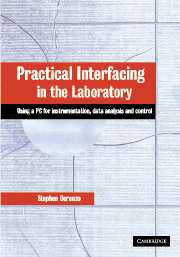Book contents
- Frontmatter
- Contents
- Preface
- Acknowledgments
- 1 Digital tools
- 2 Analog tools
- 3 Analog ↔ digital conversion and sampling
- 4 Sensors and actuators
- 5 Data analysis and control
- Appendix A Grounding and shielding
- Appendix B Experimental uncertainties
- Appendix C C programming tips
- Appendix D Numerical methods and C functions
- Appendix E Summary of Data Translation DT3010 PCI plug-in card
- Appendix F Using the digital oscilloscope to record waveforms
- Appendix G Electrical hazards and safety
- Appendix H Standard resistor and capacitor values
- Appendix I ASCII character set codes
- Glossary
- Index
- References
1 - Digital tools
Published online by Cambridge University Press: 04 August 2010
- Frontmatter
- Contents
- Preface
- Acknowledgments
- 1 Digital tools
- 2 Analog tools
- 3 Analog ↔ digital conversion and sampling
- 4 Sensors and actuators
- 5 Data analysis and control
- Appendix A Grounding and shielding
- Appendix B Experimental uncertainties
- Appendix C C programming tips
- Appendix D Numerical methods and C functions
- Appendix E Summary of Data Translation DT3010 PCI plug-in card
- Appendix F Using the digital oscilloscope to record waveforms
- Appendix G Electrical hazards and safety
- Appendix H Standard resistor and capacitor values
- Appendix I ASCII character set codes
- Glossary
- Index
- References
Summary
Introduction
In the past few years, enormous advances have been made in the cost, power, and ease of use of microcomputers and associated analog and digital circuits. It is now possible, with a relatively small expenditure, to purchase a microcomputer system that will take data, quickly analyze them, and display the results or control a process. This has been made possible by the development of technology that can fabricate millions of transistors, diodes, resistors, capacitors, and conductors on a single silicon integrated circuit chip.
Normally, the microcomputer is equipped with a number of standard items: the microprocessor chip and associated circuits, random-access memory chips, removable floppy and cartridge disk drives, magnetic hard disk drives, optical disk drives, keyboards, video display screens, serial interfaces, printers, and x–y entry devices such as the mouse, trackball, joystick, bitpad, and touch-sensitive display screen. However, data acquisition and control require additional components, such as digital and analog input/output (I/O) ports, and counters/timers. Analog input ports contain analog multiplexers, sample-and-hold (S/H) amplifiers, and analog-to-digital (A/D) converters. Analog output ports contain digital-to-analog (D/A) converters.
Even for designs requiring only a microprocessor and a few additional circuits, there are considerable advantages to using the resources of the microcomputer during the development stage. These include program code editors and compilers, an operating system for the storage and manipulation of code and data files, and ample random-access memory.
- Type
- Chapter
- Information
- Practical Interfacing in the LaboratoryUsing a PC for Instrumentation, Data Analysis and Control, pp. 1 - 52Publisher: Cambridge University PressPrint publication year: 2003



